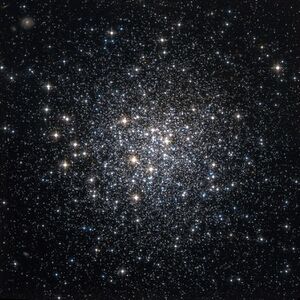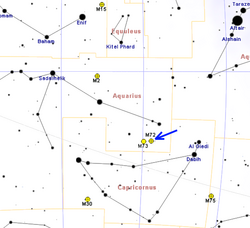Messier 72
Topic: Astronomy
 From HandWiki - Reading time: 4 min
From HandWiki - Reading time: 4 min
| Messier 72 | |
|---|---|
 M72 from Hubble Space Telescope; 3.44′ view | |
| Observation data (J2000 epoch) | |
| Class | IX[1] |
| Constellation | Aquarius |
| Right ascension | 20h 53m 27.70s[2] |
| Declination | –12° 32′ 14.3″[2] |
| Distance | 54.57 ± 1.17 kly (16.73 ± 0.36 kpc)[3] |
| Apparent magnitude (V) | 9.3[4] |
| Apparent dimensions (V) | 6.6' |
| Physical characteristics | |
| Mass | 1.68×105[5] M☉ |
| Metallicity | [math]\displaystyle{ \begin{smallmatrix}\left[\ce{Fe}/\ce{H}\right]\end{smallmatrix} }[/math] = –1.48 ± 0.03[3] dex |
| Estimated age | 9.5 Gyr[6] |
| Other designations | NGC 6981, GCl 118[7] |
Messier 72 (also known as M72 or NGC 6981) is a globular cluster in the south west of the very mildly southern constellation of Aquarius.
Observational history and guide
M72 was discovered by astronomer Pierre Méchain in 1780.[lower-alpha 1] His countryman Charles Messier looked for it 36 days later, and included it in his catalog.[8] Both opted for the then-dominant of the competing terms for such objects, considering it a faint nebula rather than a cluster. With a larger instrument, astronomer John Herschel called it a bright "cluster of stars of a round figure". Astronomer Harlow Shapley noted a similarity to Messier 4 and 12.[9]
It is visible in a good night sky as a faint nebula in a telescope with a 6 cm (2.4 in) aperture. The surrounding field stars become visible from a 15 cm (5.9 in)-aperture device. One of 25 cm (9.8 in) will allow measurement of an angular diameter of 2.5 ′. At 30 cm (12 in) the core is clear: its 1.25 ′ diameter, meaning a broad spread; and small parts scarcer in stars to the south and east.[10]
Properties
Based upon a 2011 census of variable stars, the cluster is 54.57 ± 1.17 kly (16.73 ± 0.36 kpc) away from the Sun.[3] It has an estimated combined mass of 168,000[5] solar masses (M☉) and is around 9.5 billion years old. The core region has a density of stars that is radiating 2.26 times solar luminosity (Template:Lo) per cubic parsec.[6] There are 43 identified variable stars in the cluster.[3]
See also
References and footnotes
- ↑ Shapley, Harlow; Sawyer, Helen B. (August 1927), "A Classification of Globular Clusters", Harvard College Observatory Bulletin 849 (849): 11–14, Bibcode: 1927BHarO.849...11S.
- ↑ 2.0 2.1 Goldsbury, Ryan et al. (December 2010), "The ACS Survey of Galactic Globular Clusters. X. New Determinations of Centers for 65 Clusters", The Astronomical Journal 140 (6): 1830–1837, doi:10.1088/0004-6256/140/6/1830, Bibcode: 2010AJ....140.1830G.
- ↑ 3.0 3.1 3.2 3.3 Figuera Jaimes, R. et al. (October 2011), Henney, W. J.; Torres-Peimbert, S., eds., "XIII Latin American Regional IAU Meeting: (item) The Globular Cluster NGC 6981: Variable stars population, physical parameters and astrometry", Revista Mexicana de Astronomía y Astrofísica, Serie de Conferencias 40: pp. 235–236, Bibcode: 2011RMxAC..40..235F.
- ↑ "Messier 72". https://messier.seds.org/m/m072.html.
- ↑ 5.0 5.1 Boyles, J. et al. (November 2011), "Young Radio Pulsars in Galactic Globular Clusters", The Astrophysical Journal 742 (1): 51, doi:10.1088/0004-637X/742/1/51, Bibcode: 2011ApJ...742...51B.
- ↑ 6.0 6.1 Sollima, A. et al. (April 2008), "The correlation between blue straggler and binary fractions in the core of Galactic globular clusters", Astronomy and Astrophysics 481 (3): 701–704, doi:10.1051/0004-6361:20079082, Bibcode: 2008A&A...481..701S
- ↑ "NGC 6981". SIMBAD. Centre de données astronomiques de Strasbourg. http://simbad.u-strasbg.fr/simbad/sim-basic?Ident=NGC+6981.
- ↑ Garfinkle, Robert A. (1997), Star-Hopping: Your Visa to Viewing the Universe, Cambridge University Press, p. 266, ISBN 978-0521598897, https://books.google.com/books?id=40JzBYGREL0C&pg=PA266
- ↑ Burnham, Robert (1978), Burnham's Celestial Handbook: An Observer's Guide to the Universe Beyond the Solar System, Dover Books on Astronomy Series, 1 (2nd ed.), Courier Dover Publications, pp. 188–189, ISBN 978-0486235677, https://books.google.com/books?id=xq9MGuJvh8gC&pg=PA188
- ↑ Luginbuhl, Christian B.; Skiff, Brian A. (1998), Observing Handbook and Catalogue of Deep-Sky Objects (2nd ed.), Cambridge University Press, p. 25, ISBN 978-0521625562, https://books.google.com/books?id=MwCyjQpGU7UC&pg=PA25
- ↑ on August 29
External links
- Messier 72, SEDS Messier pages
- Messier 72, Galactic Globular Clusters Database page
- Messier 72, LRGB CCD image based on two hours total exposure
- M-72 Information
- Messier 72 on WikiSky: DSS2, SDSS, GALEX, IRAS, Hydrogen α, X-Ray, Astrophoto, Sky Map, Articles and images
Coordinates: ![]() 20h 53m 27.91s, −12° 32′ 13.4″
20h 53m 27.91s, −12° 32′ 13.4″
 |
 KSF
KSF

